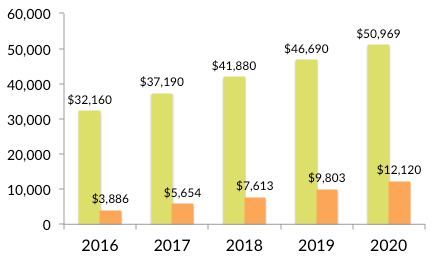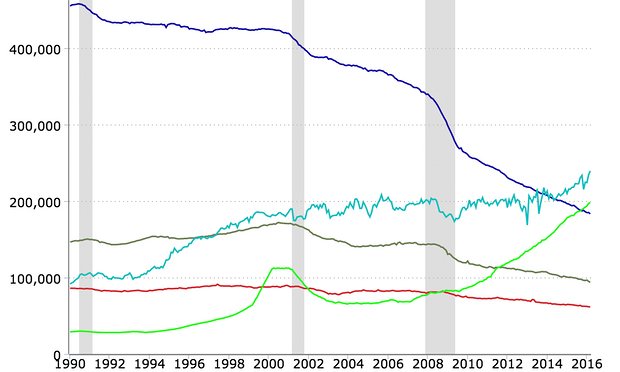The high cost of ad blocking, news consumption on social media, vanishing newspaper jobs, the booming audiobook market, and more are covered in this installment of TFP’s Media Metrics roundup.
To help you keep up with trends and prepare for changes just around the corner, each month we compile excerpts from some key reports covering issues affecting the publishing and media industries. Here are our top picks.
Ad Blocking to Cost U.S. Media Owners $12B by 2020 (The Drum)
- Optimal.com data shows 11.7% of online display ad impressions were blocked in the U.S. last year.
- Given the growing use of ad blocking technology, projections for display ad revenues for U.S. media companies in 2020 were revised down to $38.8 billion from earlier forecasts of $50 billion, a loss of $12.1 billion.
- The firm’s data from early this year shows that over 90% of blocked ad impressions are still coming from desktop vs. mobile.
Social Media Is on the Rise, but not Like You’d Expect (Columbia Journalism Review)
- The 2016 Reuters Institute Digital News Report found that among all the platforms for news consumption, including TV, radio, print, and digital, social media is the most popular: Half of 50,000 survey respondents across 26 countries said they use social media for news, with 12% saying it’s their primary news source.
- In the U.S., 17% of respondents said their first contact with news in the morning is via their smartphone, while only 6% said the same about print newspapers.
- While video is booming, the report found many news consumers are “resistant to watching video because it is faster to read an article” and they don’t want to view ads before watching the news.
- Video is most popular in the U.S. (33%), and active social media users are about 50% more likely to view online news video, it said.
Almost 60% of U.S. Newspaper Jobs Vanish in 26 Years (Guardian)
- According to the U.S. Bureau of Labor Statistics, newspaper jobs are rapidly disappearing, down from about 458,000 in 1990 to 183,000 in March 2016. That reflects a decline of nearly 60%.
- During the same time, Internet publishing and online broadcasting jobs jumped from 30,000 to almost 198,000. Those job numbers started to take off in 2008, at which time the total was 80,000, the report said.
- About 240,000 media jobs are in film and video production, a 162% increase over the past 25 years, while the number of people working in radio broadcasting has decreased by 27% since 1990.
Digital Audiobook Sales Rose 38.9% in 2015 (Good E-Reader)
- Digital audiobook sales jumped almost 40% last year, with overall digital audio bringing in $205.6 million while physical audio fell by 5.7%.
- About 3.88 million audiobooks were downloaded in 2015 compared with 2.47 million e-books.
- According to the Association of American Publishers, 2015 publishing industry sales in general fell by 2.6% year over year. Adult books and books from religious presses were the only bright spots, with sales increases of 2.2% and 1.2%, respectively.
Reuters Finds Readers Want Quality News, but Aren’t Willing to Pay for It (Digiday)
- A Reuters poll found 81% of respondents believe certain news brands are “synonymous with trusted content,” and nine out of 10 said they seek out a particular news outlet to verify breaking news.
- However, two-thirds of those respondents said they wouldn’t pay for any online content no matter the quality of the content.
- Some 58% of respondents said virtual reality will influence the way they consume news in the future, followed by wearable devices (60%) and artificial intelligence and robotics (67%). Other factors in future news consumption included the Internet of Things and mobile apps in general, cited by 80% and 89% of respondents, respectively.
Coming, the Boom in Social Media Video Advertising (Media Life Magazine)
- Last year, 15.7% of all video ad spending was on Facebook, according to a Cowen and Co. survey.
- That figure is expected to increase to 18.7% this year, while projections show TV video advertising will drop from 54.5% to 51.6% of total spending.
- The survey found video accounted for 17.7% of all digital ad spending last year and is expected to grow to 19.7% of spending this year.
Facebook Is Still King for Marketers (Folio)
- In a recent Socialfresh poll, 96% of marketers said Facebook generates the best ROI, followed by Twitter (63.5%) and Instagram (40%).
- The same held true in terms of platforms marketers advertise on at least once a month, with Facebook at 61%, Twitter at 32%, and Instagram at 30%.
- Facebook is the top platform advertisers plan to invest in over the next year (76%), while Instagram edged out Twitter, at 42% and 41%, respectively.
- Just 11% of respondents said they will increase their investment on Snapchat in the next year.
Nearly 1 in 4 People Abandon Mobile Apps After Only One Use (TechCrunch)
- Analytics firm Localytics said mobile app user retention ticked up a bit this year, from 34% in 2015 to 38% in 2016.
- Still, even with the increase, 62% of users will use an app fewer than 11 times.
- This year, 23% of users will launch an app only once, a slight improvement over the 2014 figure (20%).
- Some 26% of users abandon apps without in-app messaging after one use. In contrast, apps that have in-app messaging are abandoned after the initial launch by just 17% of users.
U.S. Publishing Earned $28 Billion in 2015 (Digital Book World)
- According to the latest survey by the Association of American Publishers, the U.S. publishing industry earned $27.78 billion in net revenue last year, accounting for 2.71 billion units sold.
- Year over year, numbers were flat, however, with a 0.6% decrease in revenue from $27.96 billion in 2014 and a 0.5% increase in volume from 2.70 billion.
- The biggest growth in 2015 was in the adult book category, which rose 6% from $9.87 billion in 2014 to $10.47 billion in 2015. Adult nonfiction books, including popular adult coloring books, accounted for the most units sold and generated the most revenue in the trade category.
5 Signs We’ve Hit Peak Tablet and How that Affects Your Publishing Strategy (The Media Briefing)
- GlobalWebIndex research found signs that tablets have peaked, with the number of users who say they own a tablet device dropping from 47% at the beginning of 2015 to 42% today. The report said usage lags particularly among young smartphone users.
- Just 4% of survey respondents said tablets are their most important devices for online use.
- According to the report, tablets beat out mobile phones in only three categories, all entertainment-related.
Mobile Video to Hit $25B Globally in 5 Years (Media Post)
- Strategy Analytics reported worldwide mobile video revenue will hit $25 billion by 2021, with most of that coming from advertisers looking to reach a fast-growing mobile video audience.
- Ad spending on mobile video will grow at a 28% compound annual growth rate over the next five years, according to the firm’s estimates.
- Advertising accounted for just 2% of worldwide mobile video revenue in 2010, but jumped to 40% this year. By 2021, that figure will reach 66%.
- The research predicts that the number of mobile video viewers will more than double to 2 billion by the end of 2022.
Young and Old News Consumers Want to Get Their News in Very Different Ways, Says Pew (Nieman Lab)
- Not surprisingly, Pew Research Center found news consumption varies greatly depending on age: 54% of 18- to 29-year-old survey respondents said they like to get their news digitally, while that was true for just 38% of those 30 to 49 and 15% of those 50 to 64.
- While 70% of 18- to 29-year-old respondents prefer to get news on their mobile devices, only 53% of those 30 to 49 years old and 29% of those between 50 and 64 said the same.
- Consumption of mobile news is up overall, however, with 72% of respondents saying they get news on mobile devices vs. just 53% in 2013.
Media Metrics is a monthly feature from Technology for Publishing, aimed at keeping you armed with the latest industry data. If you’d like to share something you’ve read, drop us a note. And keep up with the latest industry news coverage by signing up for our This Week in Publishing emails or our Publishing Innovations newsletter.
Posted by: Margot Knorr Mancini




